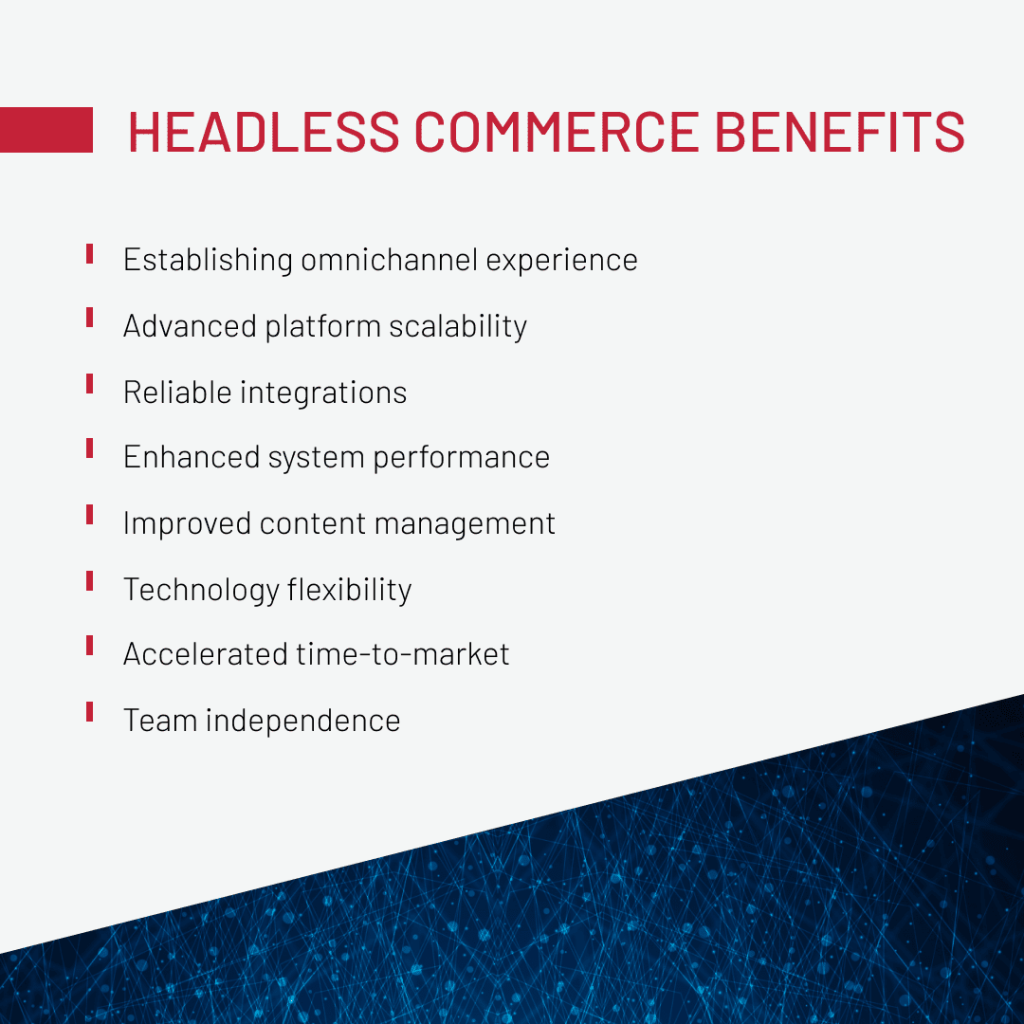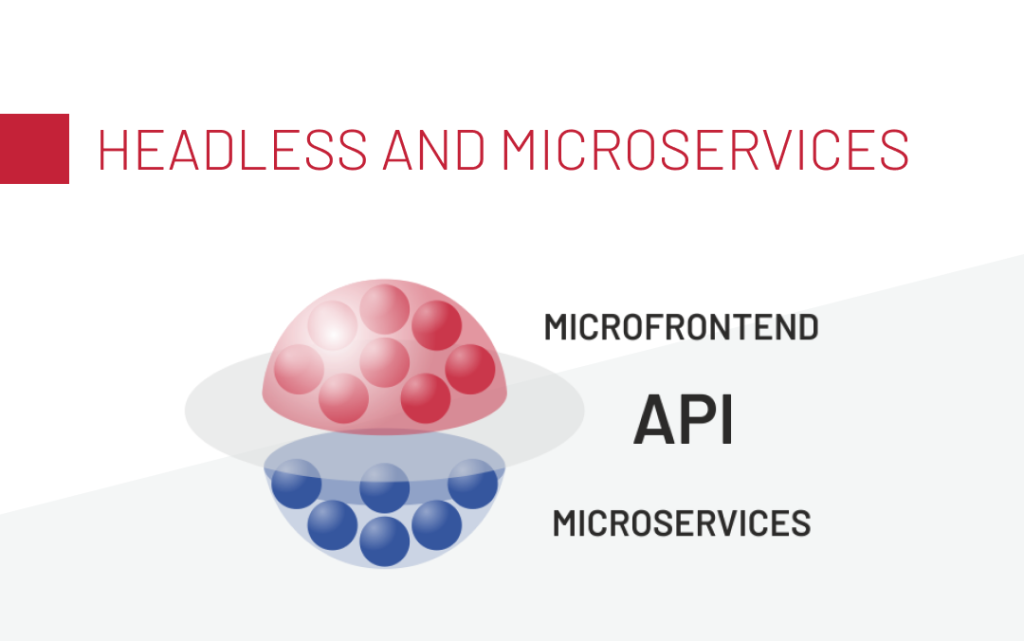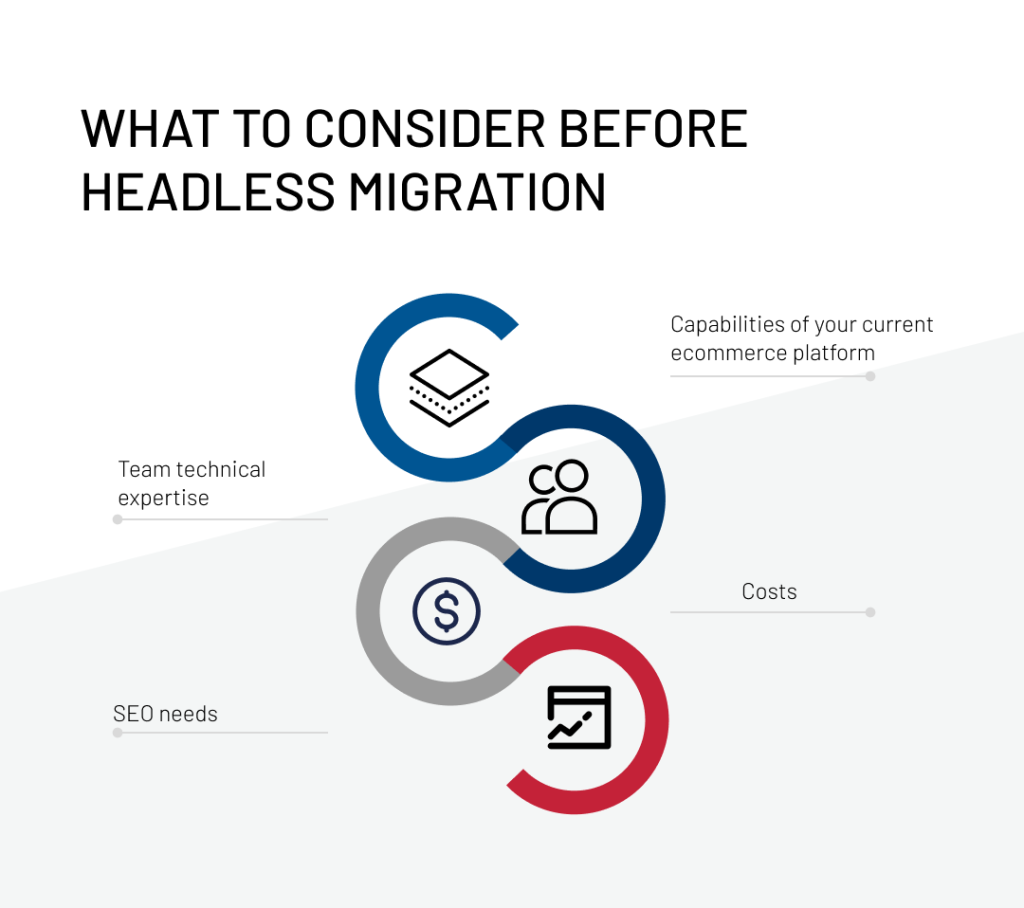9 Headless Commerce Advantages for Business

Customers today expect more than just a transaction: they crave personalized shopping experiences and seamless interactions and they want it now. But for brands tied to monolithic systems, delivering that level of service feels like chasing a moving target. These traditional ecommerce systems make it nearly impossible to scale or integrate new tech quickly enough. That’s where headless commerce comes in.
By decoupling the front- and back-ends, the headless approach allows brands to innovate faster, scale effortlessly, and stay ahead of market demands. This breakdown will take you through whether the benefits of headless commerce can support your business’s growth in today’s digital market.
What you’re going to learn:
- 1. How headless commerce improves omnichannel customer experiences.
- 2. How headless websites improve the performance of solutions and management of content.
- 3. Major things you should pay attention to before choosing a headless commerce platform.
- 4. Real examples with practical benefits of headless ecommerce for businesses.
Headless Commerce: Quick Overview
Think of your old ecommerce platform as a legacy flip phone. Sure, it works, but every time you need to update the front- or back-end, that’s akin to trying to load a modern app on outdated hardware: slow, rigid, and frustrating.
Traditional monolithic commerce platforms have tightly coupled front-end and back-end layers. This implies that for any change, the whole solution needs modification, creating very long development cycles and limiting flexibility.
So, what’s headless commerce? It unbundles the front from the back, which means separating the presentation layer from the business and data management layer. The headless site architecture allows both system parts to operate independently, using APIs as a bridge for communication and data exchange.
In a headless setup, your back-end handles core commerce functionality such as inventory, checkout, and order management. Front-end in turn can adapt quickly, whether it’s building custom mobile applications, updating a website, or deploying a new channel for improved customer journey, such as voice assistants or IoT devices.
So, what other opportunities does this headless ecommerce system decoupling bring to the table? We’ll have a detailed breakdown below.
9 Headless Commerce Advantages You Should Know

1. Establishing omnichannel experience
Headless commerce transforms the way brands manage omnichannel customer experiences by offering the technical flexibility monolithic solutions can’t match.
The centralized API layer, responsible for communication and data flow between the back-end and multiple front-end apps, allows companies to update content, features, and functionality on different touchpoints independently, without impacting the core system.
For example, a retailer managing online and offline channels can rely on headless architecture to integrate mobile apps, in-store kiosks, and point-of-sale systems. ith APIs, inventory changes are automatically synced across all channels, ensuring real-time consistency and eliminating the need for manual updates. This way, you can deliver accurate information for customers in real-time, enhancing their experience.
With headless, businesses can also much more easily establish a personalized customer experience for every channel. And according to McKinsey research, such personalization reduces customer acquisition costs by up to 50% and increases revenues by 5-15%.
2. Advanced platform scalability
In the modern online world, scalability is the name of the game. And it’s guaranteed by headless commerce platforms because of their flexible architecture.
By decoupling the front-end from the back-end, headless commerce enables the back-end to be distributed across multiple servers, containers, or data centers for optimal load balancing. This allows your solution to handle traffic spikes without compromising performance.
Now, imagine a subscription box company growing really fast, with aspirations for globalization. This is possible with headless commerce: scale into new markets, adding localized channels without reworking the core back-end. Thus, flexibility regarding adaptation for different languages and currencies or any custom features is easily maintained without compromising system performance.
Combining headless and microservices
Besides, the headless architecture can be combined with microservices, delivering even more scalability. This allows for much better resource allocations, optimized for the pattern of traffic, and permits autoscaling to adjust server capacity. Combining modern approaches, you receive a robust website that responds quickly, reduces loading times, and efficiently handles both daily operations and peak traffic demands without requiring a full redesign.

3. Reliable integrations
One of the advantages of headless commerce is flexibility in adding new tools and services. In plain words, this means the integration of third-party systems, such as CRM, payment gateways, or marketing automation platforms, on the back-end without disturbing your already-compiled infrastructure. Unlike traditional monolithic systems that require heavy rework and redeployment for each new service, the headless architecture supports seamless API-driven integration.
For example, if you want to add a new payment method, like Apple Pay or Google Wallet, to a subscription-based service, a headless setup could integrate such functionality easily using APIs without affecting the back-end operations, which also means the service and flow of data aren’t affected.
4. Enhanced system performance
Let’s start straight with the example. As a headless commerce development company, we at Expert Soft embraced a headless architecture for the customer — a leading cosmetics brand.
Using Spartacus as a headless storefront, we implemented caching of reusable elements at the front-end, such as logos, headers, and footers, reducing calls to the back-end, ultimately enhancing website performance. This speeded up page loading and led to better SEO rankings, improved customer experiences, and higher conversion rates.
To further reduce latency, decoupling content management from business logic and pre-rendering or serving content over CDNs can also be helpful. The benefit is going to be in TTFB (Time to First Byte) and responsiveness, while the front-end would make asynchronous API calls for bits of data, not pages of data.
Beyond the tech benefits, the improved load times directly touch customer experience in yielding better Core Web Vitals scores, improved SEO performance, and higher rates of engagement.
More practically, decoupling of the front-end enables granular optimization — developers can apply lazy loading, prefetching, or AMP and Progressive Web App strategies without being restrained by any back-end dependencies, which ensures that content delivery is fast and seamless across all user devices.
5. Improved content management
Working with content in a headless CMS is efficient and centralized, allowing for several fronts controlled from one back-end. So, what is the headless CMS meaning? Headless CMS is a kind of CMS that decouples content management from content delivery itself. It enables teams to create, edit, and deploy content across diverse platforms and devices unattached to a specific structure on the front-end.
This means that both tech and non-tech staff, such as marketing teams, can easily manage and update content from one central platform across websites, mobile apps, and other digital touchpoints.
For example, when launching a new campaign, the same piece of content can be created once in the CMS and distributed seamlessly across all connected front-ends, without needing redevelopment or reformatting for each.
6. Advanced security
A headless commerce solution takes ecommerce security to the next level by decoupling the front-end from the back-end, reducing exposure to vulnerabilities. By keeping sensitive data hidden behind secure APIs and encrypted connections, it minimizes the risk of breaches.
Additionally, flexible hosting options let businesses choose the most secure infrastructure available. As a result, you receive a more secure shopping experience for customers, building trust and keeping your ecommerce platform protected from modern threats.
7. Technology flexibility
Headless commerce lets you choose whatever front-end technologies and frameworks you wish for your headless ecommerce website and other available channels. This enables developers to build a modern front-end using React, Vue, or Angular among others, focusing on customer experience and performance optimization for each device.
From a technical perspective, this architecture enables independently deployable front-end services; thus, you can rebuild the user interface without risking a situation of downtime or creating dependencies that affect the operations of the back-end.
8. Accelerated time-to-market
In a business environment, your ability to release updates and new software affects your market position heavily. That’s why the time-to-market metric is of utmost importance, and headless commerce is a way of making it happen faster.
The ability of front-end and back-end developers to work independently and at the same time in tandem leads to faster implementation of new features and updates, reducing the time to market by up to 50%. Campaigns for a new product or UI enhancement can be quickly launched to stay responsive to market trends and customers’ needs for a faster passage from development to delivery.
9. Team independence
One of the key advantages of headless commerce is the independence it offers to both back-end and front-end developers. With a decoupled architecture, the dependency between these teams is eliminated, allowing them to work simultaneously with greater speed and efficiency.
Headless in action
At Expert Soft, we experienced this benefit firsthand during a project for a top 250 cosmetics brand. Initially, the back-end was responsible for rendering parts of the front-end logic, creating dependencies that slowed down the development process.
Transitioning to a headless approach changed this dynamic. The back-end began operating exclusively through APIs, removing its dependency on front-end generation and streamlining both systems.
This architectural shift improved the separation of concerns, granting complete independence to the front-end and back-end teams. As a result, each team could work autonomously without disrupting the other, leading to smoother workflows and better development resource management. The modular nature of this setup reduced overall development costs while enabling more frequent updates and feature rollouts.
The results were significant: faster time-to-market for new features, more efficient team collaboration, and enhanced scalability across multiple channels. These outcomes highlight the flexibility and power of headless commerce in optimizing development processes and driving business growth.
For more details on this case study, you can refer to our in-depth review here.
What to Consider Before Headless Migration
With all the benefits of headless commerce, not every single merchant around really needs a headless ecommerce platform. Let’s take a closer look at some crucial points to consider before you decide to move to headless.

Is headless worth the investment?
Headless architecture is ideal for brands seeking rapid adaptation and innovation in a constantly evolving market. While this approach can benefit companies of any size, it is especially advantageous for enterprises and large businesses. Headless allows these organizations to scale quickly, customize their platforms, and integrate multiple digital channels for unified customer experience seamlessly.
However, for smaller businesses, the technical complexity and higher upfront development and maintenance costs can be prohibitive. Most small platforms don’t require the level of customization or scalability that headless offers, making the traditional monolithic architecture a more cost-effective and manageable choice.
Current ecommerce platform
Not all platforms are equally suited for headless architecture, and some excel in this environment better than others. For example, SAP Commerce Cloud paired with the headless storefront Spartacus is a powerful combination that offers the flexibility and scalability large enterprises need. This setup allows businesses to create customized, fast, and seamless experiences across multiple channels.
At Expert Soft, we specialize in SAP Commerce Cloud combined with Spartacus developing scalable headless solutions to meet complex multichannel requirements. With SAP Commerce Cloud, the back-end is agile, while Spartacus covers custom front-end experiences, thus enabling SPAs and PWAs.
The combination has ensured efficient and reliable back-end infrastructure with independent front-end development and resulted in faster deployment and scalability for B2B and B2C platforms.
More examples of ecommerce platforms suitable for the headless approach are Shopify, Bigcommerce, Salesforce Commerce Cloud, and more.
Technical expertise
Headless commerce requires quite a sophisticated technical setup. Both the front-end and the back-end need to be managed in different environments independently. Software maintenance will be more complex because the teams need to make sure that API testing and deployment are regular and consistent at both layers.
If your team lacks this expertise along with required front-end and back-end technologies, adopting headless could pose significant challenges. However, you don’t need to do it alone.
You can partner with a specialized team, such as Expert Soft, to handle the complexities of headless development, from selecting the right tech stack to managing hosting and deployment. We’ve helped enterprises overcome technical hurdles and successfully implement headless solutions, ensuring their platforms remain agile and scalable.
Cost
Another important consideration is the cost. The initial investment in custom development and maintenance could be higher in the headless architecture because of its complexity and the need for advanced infrastructure. In such a case, businesses must weigh whether their current team already has experience in headless commerce development.
However, these costs typically pay off in scalability and performance benefits in the long term. A well-cared-for headless environment means speedier updates across multiple touchpoints.
SEO and flexibility
Headless commerce can boost SEO significantly since it can shrink page load times, which is a known ranking factor. But you have to optimize your headless configuration for search engine indexing.
A poorly optimized headless configuration might badly affect your SEO, since search engines may have a problem crawling and indexing content if implemented incorrectly. Proper configuration, such as SSR or dynamic rendering, is the key to making your content accessible to search engines.
Summing Up
If you’re aiming for an architecture that’s flexible, secure, and performance-oriented and can serve a personalized experience to your customers, then headless commerce is the answer.
We at Expert Soft have experience in successfully transforming business infrastructures toward headless architectures to gain better site performance, reduce time-to-market, and enable easy integrations. Whether scaling your ecommerce platform, experimenting with emerging technologies, or building a solution ready to grow with your business, headless commerce is capable of giving you the speed and agility needed.
Ready to see how headless commerce takes your business to the next level? Let’s explore how we can craft a solution to fit your particular needs. Contact us to start the conversation today!
FAQ
-
1. What are the drawbacks of headless commerce?
Despite numerous advantages of headless commerce, it can be more costly since it requires separate front-end and back-end development, which means more initial investment. Additionally, ensuring proper API integrations and seamless communication between systems is crucial to providing a smooth experience for both users and developers. However, while these are some challenges that contribute to complexity, the long-term gains in performance, flexibility, and scalability often outweigh the initial drawbacks.
-
2. Can headless commerce be implemented in any industry?
Yes, headless commerce can be implemented across various industries, from retail and fashion to healthcare, and beyond. Its flexibility allows it to fit any business that requires a seamless purchase journey, and a multichannel experience.
-
3. Is headless commerce suitable for all types of businesses?
While headless commerce provides several key benefits, it doesn’t always work out as the right solution for every business, particularly smaller businesses with very few technical resources or very simple ecommerce needs. It finds its perfect application in businesses that need high customization, unified customer experiences across multiple channels, and scalability, usually found in larger or rapidly growing businesses.

Kate is responsible for forming successful partnerships with customers and software teams to deliver quality solutions. Having worked with clients who embrace headless architectures, Kate has observed firsthand how the approach benefits businesses.
New articles

See more

See more

See more

See more

See more
